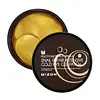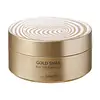What's inside
What's inside
 Key Ingredients
Key Ingredients

 Benefits
Benefits

 Concerns
Concerns

No concerns
 Ingredients Side-by-side
Ingredients Side-by-side

Water
Skin ConditioningGlycerin
HumectantCalcium Chloride
AstringentCeratonia Siliqua Gum
EmollientXanthan Gum
EmulsifyingNiacinamide
SmoothingDipropylene Glycol
HumectantMethylpropanediol
SolventSnail Secretion Filtrate
Skin Conditioning1,2-Hexanediol
Skin ConditioningPentylene Glycol
Skin ConditioningCitrus Grandis Seed Extract
AstringentBambusa Textilis Stem Extract
Skin ConditioningPinus Palustris Leaf Extract
TonicChondrus Crispus Powder
AbrasiveHydrolyzed Collagen
EmollientPEG-60 Hydrogenated Castor Oil
EmulsifyingEthylhexylglycerin
Skin ConditioningPhellinus Linteus Extract
Skin ConditioningInonotus Obliquus Extract
Skin ConditioningGold
Cosmetic ColorantAdenosine
Skin ConditioningOctapeptide-7
Skin ProtectingSh-Octapeptide-4
AntioxidantSh-Oligopeptide-4
Skin ConditioningSh-Decapeptide-7
AntioxidantSh-Decapeptide-9
Skin ConditioningSh-Pentapeptide-19
Skin ConditioningCaffeoyl Tripeptide-1
AntioxidantHydroxyethylcellulose
Emulsion StabilisingSynthetic Fluorphlogopite
Tin Oxide
AbrasiveTitanium Dioxide
Cosmetic ColorantCI 77491
Cosmetic ColorantPhenoxyethanol
PreservativeDisodium EDTA
Parfum
MaskingWater, Glycerin, Calcium Chloride, Ceratonia Siliqua Gum, Xanthan Gum, Niacinamide, Dipropylene Glycol, Methylpropanediol, Snail Secretion Filtrate, 1,2-Hexanediol, Pentylene Glycol, Citrus Grandis Seed Extract, Bambusa Textilis Stem Extract, Pinus Palustris Leaf Extract, Chondrus Crispus Powder, Hydrolyzed Collagen, PEG-60 Hydrogenated Castor Oil, Ethylhexylglycerin, Phellinus Linteus Extract, Inonotus Obliquus Extract, Gold, Adenosine, Octapeptide-7, Sh-Octapeptide-4, Sh-Oligopeptide-4, Sh-Decapeptide-7, Sh-Decapeptide-9, Sh-Pentapeptide-19, Caffeoyl Tripeptide-1, Hydroxyethylcellulose, Synthetic Fluorphlogopite, Tin Oxide, Titanium Dioxide, CI 77491, Phenoxyethanol, Disodium EDTA, Parfum
Water
Skin ConditioningGlycerin
HumectantChondrus Crispus
MaskingButylene Glycol
HumectantSnail Secretion Filtrate
Skin ConditioningAgar
MaskingColloidal Gold
AntimicrobialCeratonia Siliqua Gum
Emollient1,2-Hexanediol
Skin ConditioningCaprylyl Glycol
EmollientSynthetic Fluorphlogopite
Titanium Dioxide
Cosmetic ColorantIron Oxides
Tin Oxide
AbrasiveChlorphenesin
AntimicrobialGlycyrrhiza Glabra Root Extract
BleachingCamellia Sinensis Leaf Extract
AntimicrobialZingiber Officinale Root Extract
MaskingSchisandra Chinensis Fruit Extract
Skin ConditioningCoptis Japonica Root Extract
Skin ConditioningWater, Glycerin, Chondrus Crispus, Butylene Glycol, Snail Secretion Filtrate, Agar, Colloidal Gold, Ceratonia Siliqua Gum, 1,2-Hexanediol, Caprylyl Glycol, Synthetic Fluorphlogopite, Titanium Dioxide, Iron Oxides, Tin Oxide, Chlorphenesin, Glycyrrhiza Glabra Root Extract, Camellia Sinensis Leaf Extract, Zingiber Officinale Root Extract, Schisandra Chinensis Fruit Extract, Coptis Japonica Root Extract
 Reviews
Reviews

Ingredients Explained
These ingredients are found in both products.
Ingredients higher up in an ingredient list are typically present in a larger amount.
1,2-Hexanediol is a synthetic liquid and another multi-functional powerhouse.
It is a:
- Humectant, drawing moisture into the skin
- Emollient, helping to soften skin
- Solvent, dispersing and stabilizing formulas
- Preservative booster, enhancing the antimicrobial activity of other preservatives
Ceratonia Siliqua Gum is extracted from the seeds of the carob tree. You might know this ingredient as Carob Gum or Locust Bean Gum. It is used to stabilize other ingredients and improve the texture of products.
Carob gum is made up of long-chain polysaccharides. This makes it a natural thickener.
Yes! This ingredient comes from the seeds of a tree. The name 'Locust Bean Gum' can be misleading.
Learn more about Ceratonia Siliqua GumGlycerin is already naturally found in your skin. It helps moisturize and protect your skin.
A study from 2016 found glycerin to be more effective as a humectant than AHAs and hyaluronic acid.
As a humectant, it helps the skin stay hydrated by pulling moisture to your skin. The low molecular weight of glycerin allows it to pull moisture into the deeper layers of your skin.
Hydrated skin improves your skin barrier; Your skin barrier helps protect against irritants and bacteria.
Glycerin has also been found to have antimicrobial and antiviral properties. Due to these properties, glycerin is often used in wound and burn treatments.
In cosmetics, glycerin is usually derived from plants such as soybean or palm. However, it can also be sourced from animals, such as tallow or animal fat.
This ingredient is organic, colorless, odorless, and non-toxic.
Glycerin is the name for this ingredient in American English. British English uses Glycerol/Glycerine.
Learn more about GlycerinSnail Secretion Filtrate is the excretion from snails. It is an effective moisturizer and promotes collagen production.
A popular nickname for this ingredient is 'Snail Mucin'.
Snail mucin has numerous skin benefits:
On top of this, Snail Secretion Filtrate contains a variety of vitamins and minerals. These include copper peptides, Vitamin A, and vitamin E. Vitamins A and E are antioxidants. Antioxidants help fight free-radicals that damage skin cells.
Being cruelty-free means a brand does not experiment on animals.
If you're worried about the well-being of the snails, we recommend looking more into the company of the product. Many brands have developed humane methods to collect snail mucin.
There is much debate on this subject. On one hand, this ingredient comes from an animal. On the other hand, many will argue the ingredient is naturally secreted (like a natural by-product) and therefore vegan. If you have reservations, you can look into Galactomyces Ferment Filtrate or Centella Asiatica Extract as alternatives.
Learn more about Snail Secretion FiltrateSynthetic Fluorphlogopite is the synthethic version of mica. It consists of fluorine, aluminum and silicate.
Synthetic Fluorphlogopite is used to add volume to products.
It is considered non-irritating on the skin.
Learn more about Synthetic FluorphlogopiteTin Oxide is an inorganic oxide used to add opacity and volume to a product. In nature, it is already found in mineral form. The main ore of tin is an opaque and shiny mineral called casseterite.
Tin Oxide helps remove translucency in a product, or make it more opaque. Besides adding opacity, tin oxide is used for bulking to add volume.
Titanium dioxide is a mineral UV filter widely used in sunscreens and cosmetics.
It is one of only two UV filters officially classified as “mineral” by regulatory agencies, the other being zinc oxide.
Titanium dioxide provides broad-spectrum protection mostly in the UVB and UVAII range, with some protection in the UVAI range.
While its UVA protection isn’t as strong as zinc oxide’s, the difference is minor.
A common myth is that mineral UV filters reflect UV light. However, modern research shows titanium dioxide absorbs UV radiation like chemical filters (~95% absorption & 5% reflection).
Thanks to its non-irritating nature, titanium dioxide is suitable for sensitive, acne-prone, or redness-prone skin. It is unlikely to cause "eye sting" like other sunscreen ingredients.
A major drawback of this ingredient is its white cast and thick texture. This is why mineral sunscreens often leave a white cast and are less cosmetically elegant than chemical/hybrid sunscreens.
To improve white cast and spreadability, micronized or nano-sized titanium dioxide is often used.
There are ongoing concerns surrounding nano-titanium oxide's impact on marine ecosystems.
There is no conclusive evidence that any form of titanium oxide (or any other sunscreen ingredients) will cause harm to marine ecosystems or coral reefs. The science is still developing but many consumers are keeping a close eye on this issue.
Please note, many destinations have reef-safety sunscreen rules. For instance, the U.S. Virgin Islands advises all visitors to use non-nano mineral sunscreens.
Nano mineral sunscreens once raised safety concerns about absorption into skin.
Extensive research has shown that they do not penetrate healthy or damaged skin; they remain safely on the surface and the top layer of dead skin (stratum corneum).
You'll likely find titanium dioxide bundled with alumina, silica, or dimethicone. These ingredients help make titanium dioxide highly photostable; this prevents it from interacting with other formula components under UV light.
Learn more about Titanium DioxideWater. It's the most common cosmetic ingredient of all. You'll usually see it at the top of ingredient lists, meaning that it makes up the largest part of the product.
So why is it so popular? Water most often acts as a solvent - this means that it helps dissolve other ingredients into the formulation.
You'll also recognize water as that liquid we all need to stay alive. If you see this, drink a glass of water. Stay hydrated!
Learn more about Water